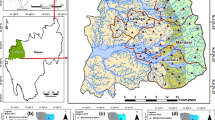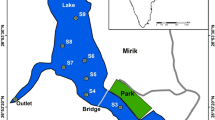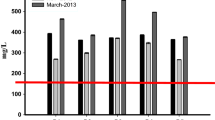Abstract
A trace elements study of various samples from the Keana brines field, middle Benue Trough was carried-out to determine the extent to which Pb–Zn–S and BaSO4 mineralisations have affected the quality of the brines and the waters in the area. Different sample media such as well-water, pond water, brine spring pool water, stream water, stream sediments etc. were analysed. Geochemical results show that Cu, Zn, Pb, As and S are concentrated in the waters (0.3, 0.36, 0.05, 0.07 and 1 1.5 ppm respectively). These elements are more concentrated in both the spring and pond waters, suggesting that the spring water could have acted as the transport medium for these elements released from deep-seated sources. Transitions elements (Ti, V, Cr, Fe, Co, Ni and Sr) are concentrated in the waters. Compared to the World Health Organization (WHO) admissible limits, the well waters present very high concentrations in Cd (0.56 ppm) and Sb (0.40 ppm) (200× and 70× WHO admissible values respectively). There is a preferential concentration of transition elements (Ti, V, Fe, Co and Ni) in the sediments (41.38, 362, 52.21, 269 and 54 ppm respectively) than in the waters (0.70, 0.05, 5.6, 0.04 and 0.02 ppm respectively). Similarly, Cu, Zn, Pb and As are concentrated in the sediments (44, 72, 41 and 14 ppm respectively). The concentrations of transition elements (Ti, V, Cr, Fe, Co and Ni) in the refined salt were highly elevated (784, 363, 283, 105, 59.2 and 42.6 ppm respectively) (7000–10,000× well water). Similarly, the concentrations of As, Pb, Br and Sr in the refined salt were also alarming (11.6, 16.4, 16.4 and 122 ppm respectively), (1000, 700, 3000 and 20,000× well water values respectively). S on the other hand is absent. One of the striking features is the absence of I, Cd, Sb and Se in the refined salt crystals which were detected in the waters and the brines. Compared to WHO admissible values, the refined salt crystal concentrations for Ni (426 ppm) and Cr (283 ppm) were also very high (2000× WHO values respectively) and to a lesser extent Cu (26.9 ppm) and Zn (21.7 ppm) (12 and 7× WHO values respectively).
Similar content being viewed by others
References
Burke KC, Whitemen AJ. (1970) Geological history of the Benue Valley and the adjacent areas. In: Carter JD, Barber WM, Tait EA. 1963 The Geology of parts of Adamawa, Bauchi and Borno provinces in North-eastern Nigeria. Bull. Geol. Surv. African Geology. University of Ibadan Press Nigeria no. 30, 108 pp, pp. 187–206
Cartchley JD, Jones GP. (1965) An interpretation of the Geology and gravity anomalies of the Benue Valley, Nigeria. Overseas Geol. Surv. Geophysics. Paper, pp. 1–26
Clarke FN. (1911) The Data of Geochemistry. 2nd edn. Washington Government Printing Office, 782 pp
Eichenberger BA, Chen KY. (1982) Origin and nature of selected inorganic constituents in natural waters. In Minear RA, Keith LH, eds 1982. Water Analysis Vol. 1 Inorganic Species Parts. London, New York: Publ. Academic Press Inc., 782 pp
JL. Farrington (1952) ArticleTitleA preliminary description of the Nigerian Lead–Zinc Field Economic Geol. 47 583–608 Occurrence Handle10.2113/gsecongeo.47.6.583
Ford SO. (1980) The Economic Mineral Resources. In: Vogel A (ed). Jour. & Earth Evol Sci. 2/1981. Vieweg and Sohn, Publ. Fredr Berlin,
Funtua II. (2000) Application of EDXRF for water analysis. An unpublished paper presented at a Workshop on Application of Nuclear Technology in Water Research, Development and Management, Sokoto, Nigeria, 17–21 July 2000, 13 pp
UA Lar N Walsh EC Ashano AE Ogezi PH. Nixon (2000) ArticleTitleMobilisation of major, minor, and trace elements (including REE) in weathered basaltic materials of the Jos Plateau, Nigeria African J Nat Sci, 3 IssueID40–56 3 40–56
FC. Loughnan (1969) Chemical Weathering of the Silicate Minerals American Elsevier Pub. Comp. New York 1–113
Montgomery CW. (1995) Environmental/Medical Geology. 4th edn. pp. 446–451
Offodile ME. (1975). A review of the geology of the cretaceous of the Benue Valley. In Geology of Nigeria. Lagos: Elizabethan Publ. Co., pp. 319–330
Offodile ME. (1976a) The Geology of the Middle Benue, Nigeria.Vol. 4. Paleo. Inst. Publ. Univ. of Uppsalla Special
ME. Offodile (1976) ArticleTitleThe geology and tectonics of the Awe brine field J Min Geo. 30 IssueID1 189–201
Offodle ME, Reyment RA. (1976) The Stratigraphy of the Keana–Awe area of the Middle Benue Region of Nigeria. Vol. 7. Bull. Of Geol, Inst. Of the Univ. of Uppsala, NS
Reyment RA. (1965) Aspects of the Geology of Nigeria. Ibadan Univ. Press, 145 pp
Sabo OA. (1985) The Geology of the area East of Keana, Nigeria. Unpublished B.Sc. -Thesis, University of Hull, 83 pp
AK. Sallau (2002) Trace element geochemistry of the Keana brines field, middle Benue trough, Nigeria. Unpublished M.Sc. Thesis University of Jos. Jos-Nigeria 146
K. Shoneick (2002) Water quality Lecture notes. Department of Geology ABU Zaria 20
M Thompson JN. Walsh (1989) Handbook of Inductively Coupled Plasma Spectrometry Blackie Glasgow and London 316
United Nations Children Fund (UNICEF) (2001) Publications on the rights of the Child: Essential elements, 133–142
KH. Wedepohl (Eds) (1969) Handbook of Geochemistry. Vol 2 Springer-Verlag Berlin, Heidelberg and New York
World Health Organization (WHO) Report. (1994). International Standards for drinking water. Geneva
Author information
Authors and Affiliations
Corresponding author
Rights and permissions
About this article
Cite this article
Lar, U.A., Sallau, A.K. Trace element geochemistry of the Keana brines field, middle Benue trough, Nigeria. Environ Geochem Health 27, 331–339 (2005). https://doi.org/10.1007/s10653-004-5736-7
Received:
Accepted:
Issue Date:
DOI: https://doi.org/10.1007/s10653-004-5736-7




